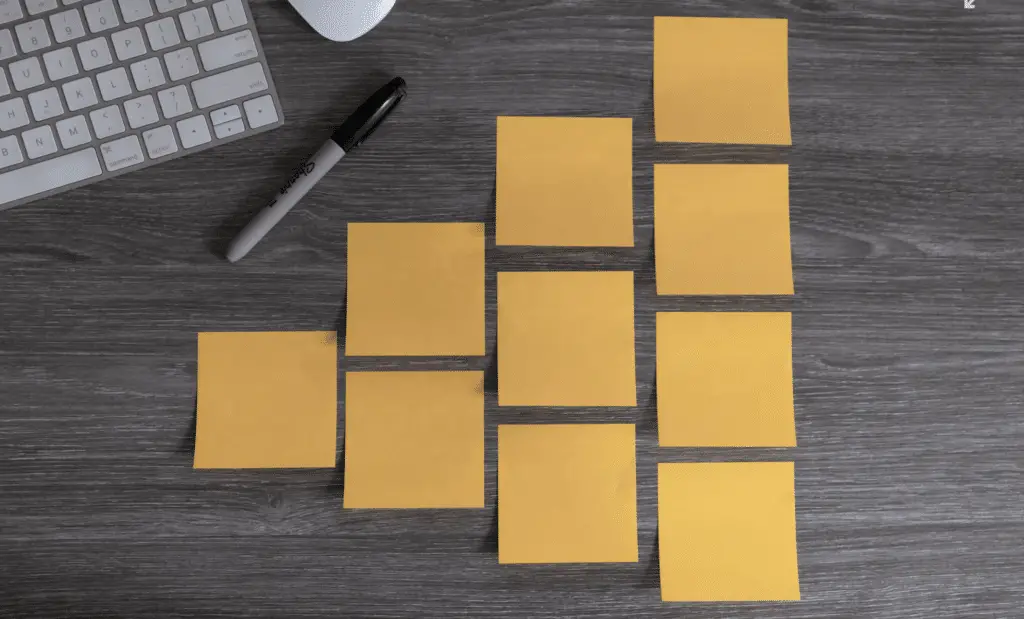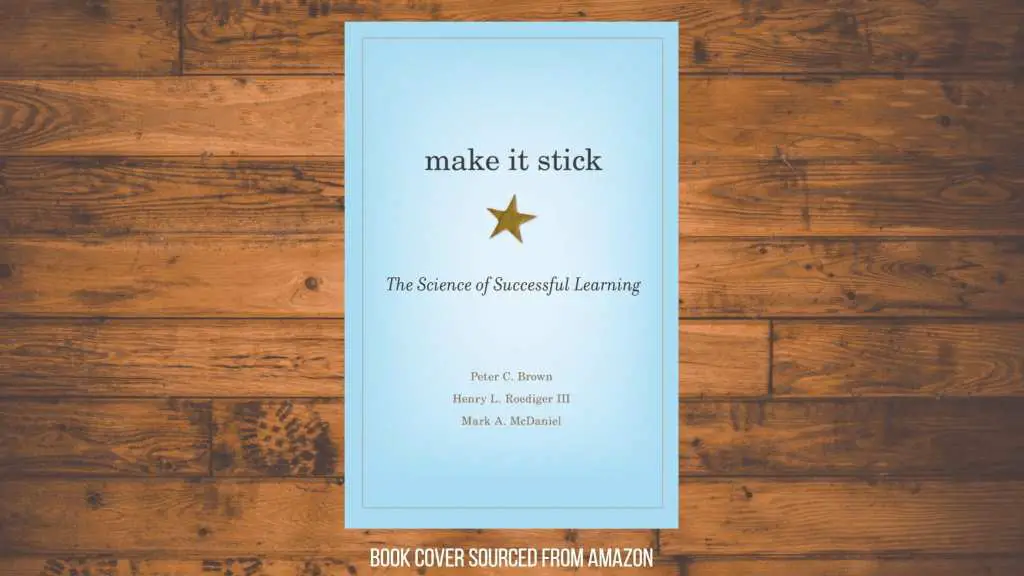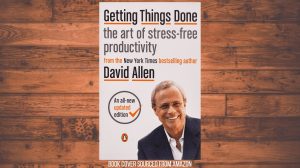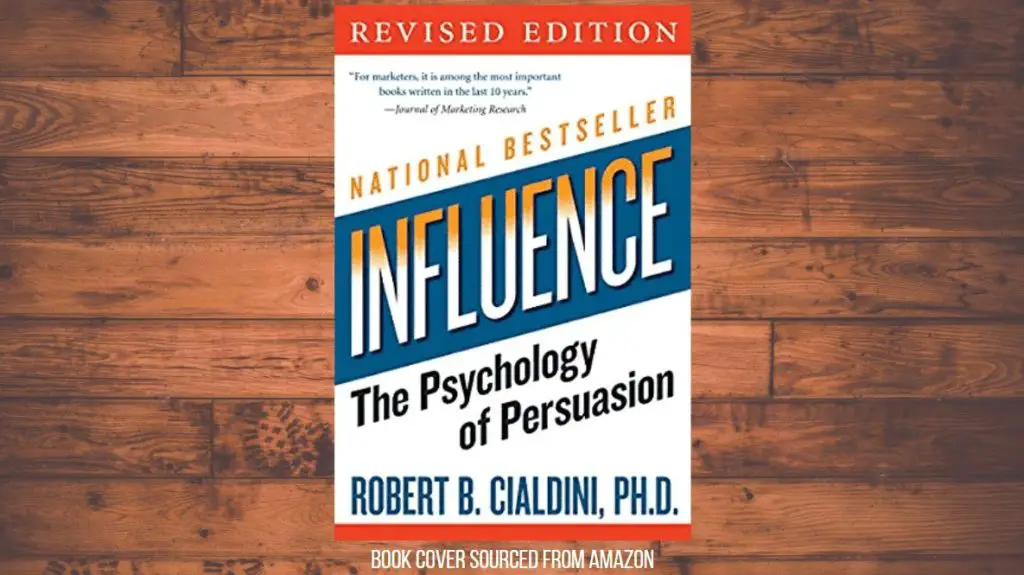This post may contain affiliate links, which means I’ll receive a commission if you purchase through my links, at no extra cost to you. Please read full disclosure for more information.
ABOUT
- Title: Make it Stick
- Sub-title: The Science of Successful Learning
- Authors: Peter C. Brown, Henry L. Roediger III, Mark A. McDaniel
- About the authors:
- Peter C. Brown is a writer and a retired management consultant living in Minnesota.
- Henry L. Roediger III is the James S. McDonnell Distinguished University Professor of Psychology at Washington University in St. Louis. He received his Ph.D. from Yale.
- Mark. A. McDaniel is a Professor of Psychology and Director of the Center for Integrative Research on Learning, and Education (CIRCLE) at Washington University in St. Louis. He researches in the area of learning and memory. He received his Ph.D. from University of Colorado.
- Pages: 336
- Published: 2014
- Link to book
HIGH-LEVEL SUMMARY

For a majority of your life (maybe all), you have been learning, most likely through a traditional education system. But how many of you were ever taught how to learn? Maybe some of you were lucky and were shown the correct and incorrect ways to learn and store information.
Personally, I was never taught why certain methods of learning were better than others.
Make it Stick makes up for that lack of education and gives readers the holy grail of learning and memory. The book draws on recent discoveries in cognitive psychology and offers practical and concrete techniques to learn faster, learn more, and forget less.
The book will debunk the most commonly used methods of learning and memorization and will equip you with the proper tools. A major pillar of Make it Stick is that the best methods for learning are often counterintuitive. This makes it hard for a person learning to identify when they are learning properly and when they are not.
It first takes awareness of why and the book offers that.
RECOMMENDATION
I would strongly recommend this book to anyone who is looking to improve and fully utilize their brain. This book will teach you effective strategies for learning that will allow you to learn faster, retain more, retain for longer, and ultimately increase your knowledge and cognitive abilities.
While I do believe any individual can benefit from Make it Stick, I think the book would be especially useful to students or those studying for certifications or admissions tests for advanced degrees. I knew about some of these techniques when I was in school, but I wish I would have read this book in high school or sometime earlier where I could have implemented this in my studies.
The knowledge in Make it Stick isn’t just applicable to learning subjects out of a book for classes. You can use the information to pick up languages, practice for interviews, improve your skill in your hobby, become better at basketball, and any other task that requires learning.
At the end of the day, if you are someone who wants to learn and do so efficiently and effectively, Make it Stick should be moved to the top of your reading list.
TOP 20 TAKEAWAYS
** In no particular order*
1. The most effective learning strategies are not intuitive and go against what your intuition would say is best.
2. The stories we create to understand ourselves become the narrative to our lives. Be cautious of the story you have about yourself.
3. Simple and practical strategies for learning and memory include retrieval practice, spacing out practice, interleaving practice of different but related topics, varying practice, and trying to solve a problem before being taught the solution.
4. We need to keep learning and remembering all of our lives. You either use it or lose it when it comes to your memory and knowledge.
5. Learning is an acquired skill and the elements that shape your intellectual abilities lie largely within your control.
6. Learning is deeper and more durable when it’s effortful. Learning that is easy is here today and gone tomorrow. You want a challenging struggle. This may take longer, but you will learn better.
7. We are poor judges of when we are learning well and when we are not. We think we are being productive, but we really aren’t learning effectively.
8. Rereading text and massed practice are the most common and preferred study strategies, but are also among the least productive.
9. Flashcards are great because they involve retrieval, which involves recalling facts from memory while testing. This is more effective than rereading.
10. Space out the practice of a subject. Periodic practice that allows for a little forgetting is good, because when you practice again, the retrieval routes with the pathways in your brain will strengthen and you will hang onto knowledge.
11. In virtually all areas of learning, you build better mastery when you use testing as a tool.
12. Familiarity with a text or fluency with reading can create an illusion of mastery. For example, you reread material until you become familiar with it. You really aren’t understanding the underlying concepts. You are just familiar with the text.
13. Practicing a single concept or skill over and over again until you have it down is not as effective as mixing up your practice and varying it with other types of different but related problems. For example, if studying geometry, don’t study problems only calculating the area of a pyramid. Study problems where one is asking for the area of a pyramid, another for a sphere, and another for a rectangle.
14. Mastery requires both the possession of ready knowledge and the conceptual understanding of how to use it.
15. Reflection can be a powerful form of learning that involves several cognitive activities.
16. Cramming can improve results for short-term tests. However, that knowledge is quickly lost. When two groups were tested at a later time, the group that crammed did worse. If you want to learn things for the long term, don’t cram.
17. Testing that requires a learner to supply an answer, such as an essay or short-answer test, is more effective for learning compared to recognition tests like multiple choice or true or false. If you test yourself, work on problems that require you to generate an answer.
18. A fear of failure can create aversions for people that will avoid risk-taking and challenging themselves so they never have to face failure. People need to develop a growth mindset and understand making errors and failing is okay because our intellectual abilities are within our own control and we can improve.
19. Long-term memory capacity is nearly limitless. The more you know, the more possible connections your mind can make for adding new knowledge.
20. There are many different forms of intelligence and you should tap into all of them for learning.
WHAT I LIKED

Tons of facts backed by research
The book is filled with facts on learning and memory and each is backed by research and supported with examples. Make it Stick will explain which methods are wrong and why they are wrong. Then it will explain better methods in simple language and explain why they are better.
Towards the end of the book, as thoughts come together, the book shares stories of people who have found success and what habits they implemented to lead to that success. The habits of the entrepreneurs, medical students, etc were ideas presented in Make it Stick.
This helped drive home the messaging after reading about how this worked out for others.
Suggestions on what the reader should do
The book doesn’t just explain the workings of the brain, but the author’s tell the reader what they should do to take the information and apply it to their lives. After reading, I now feel like I am equipped with a toolkit to use while I learn and comprehend new subjects and skills.
Additionally, this book isn’t based on one or two methods of learning. There are a variety of techniques given in this book that allow you to learn in a number of ways and keep things interesting.
I personally get bored doing the same thing over and over again, so I appreciate having a number of options.
Versatility of techniques for all skills
I like how the learning and memory techniques have versatility. This isn’t just for memorizing anatomy textbooks for college classes. You can use these techniques in sports, for your hobbies, learning a new language, and in social and professional settings.
I’m out of school, but committed to lifelong learning. As I was reading, I was brainstorming all the areas that I could apply this information. I think you would have the same experience.
It can be as simple as memorizing a grocery list better or creating a mnemonic device to remember the line items of the income statement.
Does not require gadgets, equipment, supplements, etc
Lastly, to implement the ideas in Make it Stick, all you need is your brain.
You don’t need any gadgets, equipment, or supplements to amplify your learning and memory. There are plenty of supplements out there that can help you achieve optimal brain nutrition, and in 2020, there are all types of weird gadgets you put on your head that claim to improve it’s function.
That is not what this book is about. This book is about you and your mind and changing the way you do things to make it work more efficiently. All you need to begin making life-altering changes is this book and the drive to do so.
BENEFITS FOR YOUR LIFE AND CAREER

I can’t think of a downside to being able to learn and retain what you have learned. The information given through this book will be applicable to all areas of your life for the entirety of your life.
Pick up any skill, learn faster, and forget less
First off, you will be able to pick up any skill you want with this knowledge. The principles and techniques are not restricted to only being used for reading and schoolwork. You can apply the information to skills you need for work, for hobbies, and even skill-based athletics.
You will be able to learn faster and forget less, which makes the whole process more efficient.
Compounding effect of learning
The book mentions how all learning builds upon previous learning and memory. If you are able to amplify both of those, imagine what the effects of that could be compounded over years and years.
The number 2 raised to the 10th power is 1,024. The number 3 raised to the 10th power is 59,049. Although the number only increased by 50%, the ending results are vastly different. Imagine this happening with your cognitive abilities.
Doors can open
It’s highly likely that if you read the book and took action, more doors would open for you across areas of your life. You could improve your learning and get a better GPA, a more prestigious job out of college, and score well on the GMAT to send yourself to a top 10 MBA program.
Or even socially, if you studied psychology and read a bunch of books on human behavior and social cues, you could pull from that knowledge to help you in a situation when you are interacting with a man or woman you just met. That person could end up being “the one.”
You never know. Knowledge comes into play in a number of ways. It’s best to have more of it.
Teach to others and your kids
With this book, you’ll have the golden ticket to making things stick. With this information, you can share it with others to help them out. Down the road, if you have children, you can steer them away from the less efficient but more popular methods of learning. You can teach them from a young age to learn properly.
I think it’s important for everyone to know what’s in this book and when you read it, you can share that with others to impact their trajectory as well.
Lifelong learning and brain health
All of us here on the Bizness Professionals blog strive to be our best and improve in any way we can. We’ll probably all be lifelong learners as well. If we are going to learn for the rest of our lives, we might as well be doing so in an optimal way.
Additionally, a learning mind that is challenged and engaged won’t wither away as fast from the effects of aging. You’ll stay sharp and cognitive decline will slow, allowing you to enjoy more of your life and fend off the loss of function and memory. The techniques in Make it Stick will keep your mind firing on all cylinders.
10 ACTIONS YOU SHOULD TAKE
1. Skip taking the easier route of studying. Embrace the challenge and difficulty.
2. Reflect every so often while you are studying and learning. Reflect at the end of your days at well and analyze what went well, what didn’t, and why.
3. Quit rereading material and implement the techniques of retrieval, spaced practice, varied practice, and interleaving of skills and concepts.
4. Use flashcards as a way to study and learn through recall and active learning.
5. As you go through your days, think of how skills picked up in seemingly unimportant areas can be used together and built upon for future uses.
6. Think about if you are actually understanding the ideas behind something or if you have just become familiar with the reading, lecture, video, etc.
7. Look up the Leitner box method for studying and implement it into your routine.
8. Avoid practicing one thing continually until you “get it down.” Switch up the practice. For example, in basketball, don’t just practice 15-foot jump shots for the whole session. Mix it up and shoot from everywhere under varying conditions. You’ll improve and learn more.
9. Focus on crafting a growth mindset and thoroughly believing that your abilities are within your control to change for the better.
10. Learn a brand new skill or subject and implement the techniques from this book.
RESOURCES
Make It Stick can be found on Amazon at this link here if you are interested in reading.



